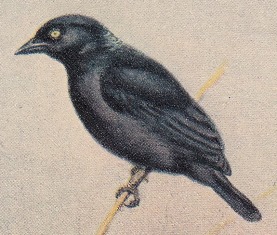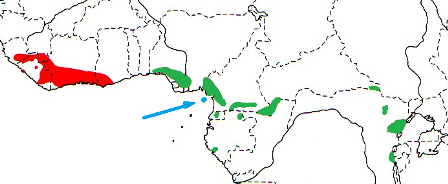Weaver Wednesday [109]: Maxwell's Black Weaver 2014-07-16 (538)
 Weaver Wednesday
Weaver Wednesday

The Maxwell's Black Weaver Ploceus albinucha is glossy black in both sexes and the eye is white to greenish-white. The nominate race has white bases to the nape feathers, showing as a pale patch. The juvenile is dark brown above, dull charcoal-grey below, and the eye is brown.
It is very similar to Vieillot’s Black Weaver, which has a yellow eye (not whitish). The juvenile Vieillot's Black Weaver has a yellow throat and belly, while the juvenile Cassins Malimbe has an orange throat.
Maxwell's Black Weaver occurs from West Africa to central Africa (see map below, based on Birds of Africa). There are three subspecies:
P. a. albinucha in Sierra Leone to Ghana (see red on map). The adult has a white nape.
P. a. holomelas, in Nigeria across to western Uganda (see green on map). The adult has a black nape, and the juvenile is grey below as is the nominate juvenile.
P. a. maxwelli, on Bioko Island (see blue on map). The adult has a black nape, and the immature is washed with yellow below.

The Maxwell's Black Weaver inhabits high forest in Cameroon; elsewhere it is found in the vicinity of villages surrounded by secondary forest, often near rivers and creeks. Maxwell's Black Weaver formst large, noisy roosts in the evening.
The Maxwell's Black Weaver feeds on insects including grasshoppers, small caterpillars, and chrysalises. It also feeds on fruit, berries, and nectar. It hawks insects in the canopy. Maxwell's Black Weaver forages in mixed-species flocks but single birds may be found high in the canopy.
The Maxwell's Black Weaver is probably polygynous. It is colonial, with 20-500 nests in a colony. It may form mixed colonies with other weaver species. The nest of Maxwell's Black Weaver is a rough hemisphere with the entrance below and almost no tunnel. The nest is constructed of thin, rough creepers, or is woven from strips of banana leaf. The nest is placed at the tip of a branch or palm frond. The nests are usually high up, in the crown of trees. A colony of 20 nests in Sierra Leone was directly below the nest of a Crowned Hawk-eagle Stephanoetus coronatus. The eggs are undescribed and nothing else is known about breeding. Young birds are sometimes harvested by villagers.
There are no PHOWN records for the Maxwell's Black Weaver (see PHOWN summary). Be the first to submit a record of this species! Submit any weaver nest records to PHOWN (PHOtos of Weaver Nests) via the Virtual Museum upload site.
PHOWN summary
Previous Wedn: Cassin's Malimbe
Full weaver species list
| 

 Weaver Watch
Weaver Watch


